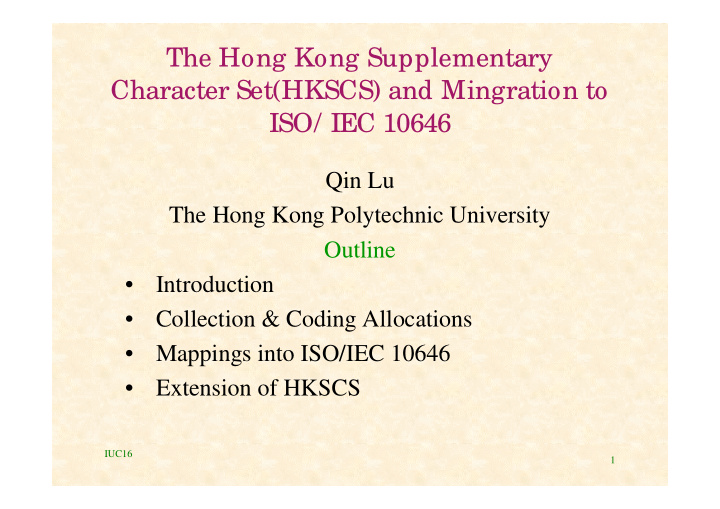



The Hong Kong Supplementary Character Set(HKSCS) and Mingration to ISO/ IEC 10646 Qin Lu The Hong Kong Polytechnic University Outline • Introduction • Collection & Coding Allocations • Mappings into ISO/IEC 10646 • Extension of HKSCS IUC16 1
• HK is a bilingual society • Majority use Big-5 based systems with 13,000 Chinese characters in traditional form • Lack of support for some Cantonese/HK unique characters • Examples: (From GCCS) • Personal names: (FAC0), (FBFB), • simplified Chinese: (9076), (9FE5) • Cantonese characters: (9DF5), (9DF6) • Variants: (90DC), (8EC4) • Foreign characters: (9DCD) IUC16 2
Government Common Character Set (GCCS) • First appeared in Govern. Tender doc. late 1995 • 3,049 characters defined in User-Defined Areas (UDCs) • Intended for Govern. internal use • Sources: Various Government Departments • Made available to public in 1997 for download with font and the Changjie input method • Marked the first attempt by HK Govern. for “standardization” IUC16 3
GCCS continued • Problems with GCCS – Not truly exchangeable – Lack of criteria for inclusion – Inclusion of “incorrect” characters: – Example: • Digital 21(Nov. 1998): HKSARG IT strategy: – Open and Common Chinese Language Interface – Adoption of ISO/IEC 10646 • Superset of Big-5 • Evolving standard and possible to include GCCS and IUC16 future extensions 4
1st Extension of GCCS • Additional 3,000 some candidate characters by May 99 collected by the Official Language Agency(OLA) • Limited code space in Big-5 • Need for inclusion criteria and the removal of “incorrect” characters(characters without clear source) • Establishment of the Chinese Language Interface Advisory Committee(May, 99) • Published in September 28, 1999 • Renamed: – Hong Kong Supplementary Character Set (HKSCS) IUC16 5
Hong Kong Supplementary Character Set (HKSCS) • 4,702 character: – 2,943 from GCCS( 106 from GCCS removed ) – 1,759 newly included • Chinese characters: 4,261 IUC16 6
• Special Symbols IUC16 7
IUC16 8
IUC16 9
• UDA3 IUC16 10
Repertoire Selection Principles • Exclusion Principles: – Characters already defined in Big-5 – Variants of character(s) defined in Big-5 that can be unified(using the ISO/IEC 10646 unification rules):84 – Characters whose source information and usage cannot be verified : 22 IUC16 11
Big-5 Coding Ranges Range Total Name of Block (Total code points) 8140 – 8DFE 2,041 User-Defined Area 3 (UDA3) 8E40 – A0FE 2,983 User-Defined Area 2 (UDA2) A140 – A3FE 471 Big-5 Symbols and Control Codes A440 – C67E 4,501 Big-5 Primary Character Set C6A1 – C8FE 408 Vendor-Defined Area (VDA1) C940 – F9D5 7,652 Big-5 Secondary Character Set F9D6 – F9FE 41 Vendor-Defined Area (VDA2) FA40 – FEFE 785 User-Defined Area 1 (UDA1) IUC16 12
HKSCS Code Allocation in Big-5 - UDA 1 (FA40 – FEFE) : 763 Characters - UDA 2 (8E40 – A0FE) : 2,898 Characters - UDA 3 (8140 – 8DFE) : 641 Characters - VDA 1 (C6A1 – C8FE) : 359 Characters - VDA 2 (F9D6 – F9FE) : 41 Characters • Future extension in UDA 3 Range Sub-blocks Purpose (Total code points) (Total code points) User-Defined Area 3 (UDA3) 8140 – 84FE Will not be used by HKSCS nor for 8140 – 8DFE (628 code points) future extensions of HKSCS. (2,041 code points) 8540 – 8DFE Reserved for HKSCS. Currently, (1,413 code points) 641 characters are defined. IUC16 13
Compatibility points • Introduced to provide full backward compatibility to GCCS • Principles: – Code points for removed characters are reserved – No new assignment of these compatibility points – Flexible implementation : • Font can be provided • Input methods can be disabled IUC16 14
HKSCS in Unicode Scheme • Mappings to both Unicode 2.0 and Unicode 3.0 • Only some characters are mapped into Private Use Area of Unicode • Use of compatibility points in PUA • Converting functions in existing systems IUC16 15
Extension of HKSCS • Will be handled by CLIAC • Public consultation paper out Friday 24 March, 2000 • 3 parts: Exclusion rules, Inclusion rules, Procedures for submission and review • Exclusion rules: – Check against Big-5 repertoire – Follow ISO/IEC 10646 unification rules – No simplified Chinese in principle Exceptions: vs. IUC16 16
• Inclusion Rules: Characters used “commonly” in HK – Characters in use (in printed materials) already a place, etc : (96F5), (8E78) vs , – Cantonese characters(may be newly created) – Characters used in personal names, building names, etc, which can be verified in major dictionary: (9254), (9068) vs – Non-regional names, new materials, names, etc – Special symbols IUC16 17
• Procedures: – Separate submissions: • Govern agencies: requires timely reply(in a matter of days) • individuals: scholarly, news papers, – Around 3 months for review, and available in internet – Publish at most once a year and stop after Extension B of ISO/IEC 10646 is published. IUC16 18
Conclusion • HKSCS is the first standard in HK • Government is playing more roles in standardization • More efforts/resources will be allocated to Unicode migration related issues • Encourage vendors to make systems that are Unicode enabled • http://www.digital21.gov.hk/chi/hkscs/download IUC16 19
Recommend
More recommend